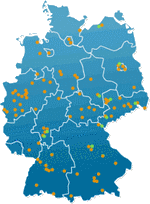Deutsches Institut für Normung
About DIN
DIN, the German Institute for Standardization, develops norms and standards as a service to industry, the state and society as a whole.
A registered non-profit association, DIN has been based in Berlin since 1917 and was founded in same year as the "Normenausschuss der deutschen Industrie (NADI)".
DIN's primary task is to work closely with its stakeholders to develop consensus-based standards that meet market requirements. Some 26,000 experts contribute their skills and experience to the standardization process.
By agreement with the German Federal Government, DIN is the acknowledged national standards body that represents German interests in European and international standards organizations. Ninety percent of the standards work now carried out by DIN is international in nature.
What does DIN stand for?
DIN stands for "Deutsches Institut für Normung", which means "German Institute for Standardization". DIN Standards are the published results of DIN's work.DIN was founded on 18 May 1917 as the "Normalienausschuss für den allgemeinen Maschinenbau" (roughly, the "Standardizing Committee for Mechanical Engineering in General").
Since then, it has undergone several name changes, as have its products - originally, German standards were called "Deutsche Industrie-Normen", or "German Industrial Standards". It wasn't until the 1970s that the name "DIN" became the official symbol for technical standardization in Germany.
What does DIN do?
DIN provides services for all stakeholders in standardization by serving as a meeting place for representatives from industry, commerce, consumers, the trades, other service providers, research organizations, technical inspection institutions and public authorities. At DIN stakeholders sit down together to develop consensus-based standards that meet market requirements.
By agreement with the German Federal Government, DIN has been the acknowledged national standards body that represents German interests in European and international standards organizations since 1975.
Who are DIN Members?
DIN has nearly 1,800 members, including individual companies, associations, public authorities, and other organizations from industry, commerce, the trades and research. DIN members help support standardization through their fees and play an active role in the decision-making process.
What is a Standard?
A technical standard represents the state of technology as determined in a consensus-based process organized by a standards body. Standards lay down general and/or detailed specifications for products, procedures and services alike.
DIN EN 45020 defines the term "standard" as a "document, established by consensus and approved by a recognized body, that provides, for common and repeated use, rules, guidelines or characteristics for activities or their results, aimed at the achievement of the optimum degree of order in a given context".

Example of DIN Standards
- DIN 476.. 1922 DIN 476 Paper formats (DIN A 4, A 3 etc.) is published
international paper sizes (now ISO 216 or DIN EN ISO 216) - DIN 946.. Determination of coefficient of friction of bolt/nut assemblies under specified conditions
- DIN 1451.. typeface used by German railways and on traffic signs
- DIN 31635.. transliteration of the Arabic language
- DIN 72552.. electric terminal numbers in automobiles
Auslegestellen
In many places (Auslegestellen) in Germany, the DIN standards and other technical standards can be consulted for free. The norms are usually accessible in electronic form, and in some "Auslegestellen" the original documents can be purchased at the same time.
Reference.. DIN Germany